I love 1970 Cadillacs. It goes way back. In first grade, my friend Luke Carlson’s mom had a 1970 Fleetwood Brougham. A coppery gold metallic, with white leather, white vinyl roof and black dash and carpet. By 1988 it was a little rough, but it still had…presence. Something you don’t really have with any modern Cadillac save the now-cancelled CT6 and current Escalade.
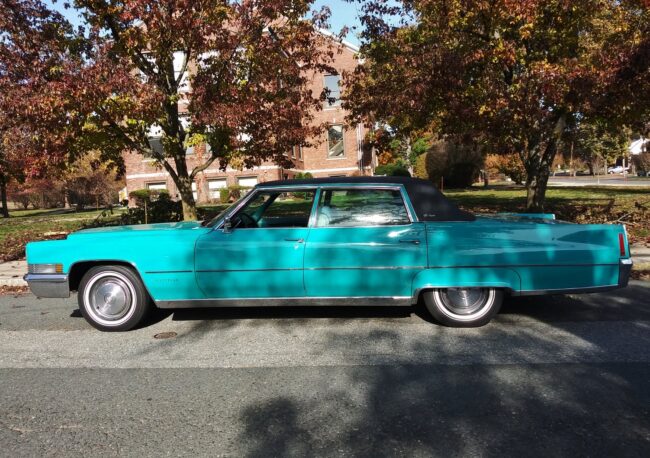
What was the last year Cadillacs were really Cadillacs. In the true and healthy post WWII, successful, gin drinking, golf playing Don Draper type businessman sense? 1964? 1966? 1972? A case could be made for any or all of those years. But I’m on my third screwdriver of the evening and don’t want to delve too deeply into it; feel free to play it out in the comments. My friend Laurie Kraynick has perhaps the most gorgeous ’70 Fleetwood Brougham in all of civilized humanity, in its choice aqua hue, with matching interior and black vinyl roof, but this morning I was drawn to this stunning example in Sable Black with gold brocade interior, espied on eBay.
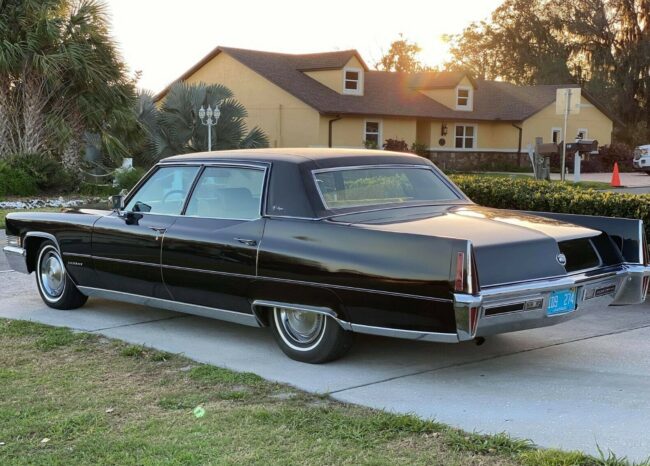
Starting with its inception in 1902 and continuing more or less through the Sixties, Cadillac produced well-built, well-finished, impressive–and expensive–cars. Inside and out, wherever you looked you saw chromed, die-cast metal, leather, fine fabrics and extensive gadgetry.
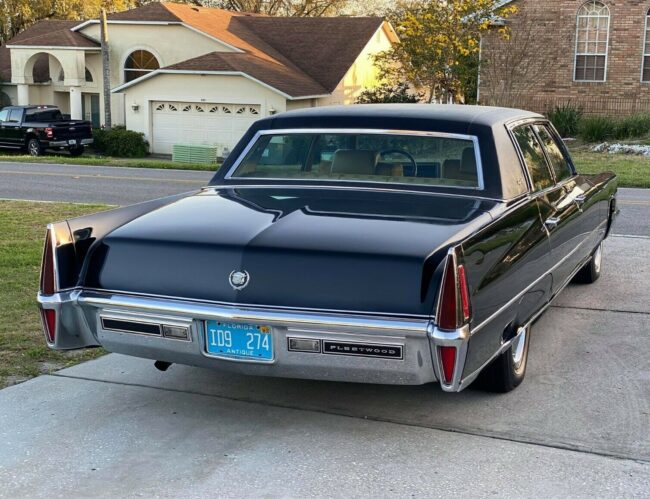
The 1970 Cadillacs were mildly restyled versions of the all-new 1969 models. In my opinion, the 1970 Cadillac is that rare case of a facelift improving on the original. The revisions involved nothing drastic, and every refinement–from the new eggcrate grille, to new wheel covers, to new taillights set above a deeper V, to the fender peaks bearing the Art Moderne Cadillac emblem–simply looked great. It didn’t hurt that the 1969 body shell was very well proportioned for a luxury car, and enhanced by a subtle character line that flowed from the top of the front fender through the door handles before melting into the rear quarters. Very elegant, and so very appropriate for a Cadillac.
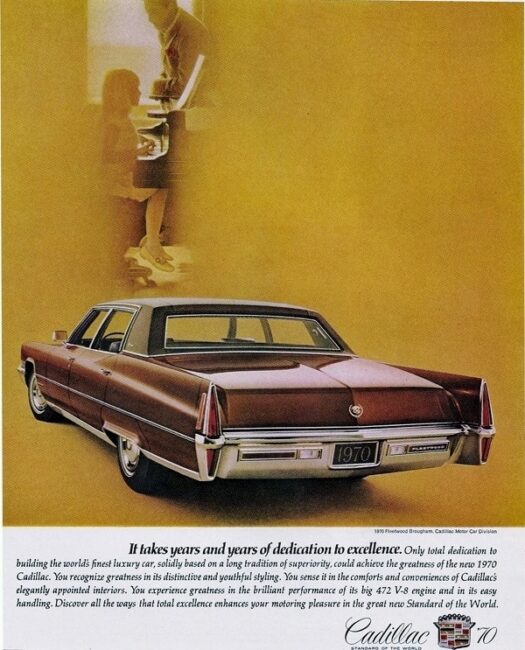 The Calais and Hardtop Sedan de Ville had an attractive “fast” C-pillar; but in my opinion, the Fleetwoods, with their traditional wide C-pillar, were the best of the bunch.
The Calais and Hardtop Sedan de Ville had an attractive “fast” C-pillar; but in my opinion, the Fleetwoods, with their traditional wide C-pillar, were the best of the bunch.
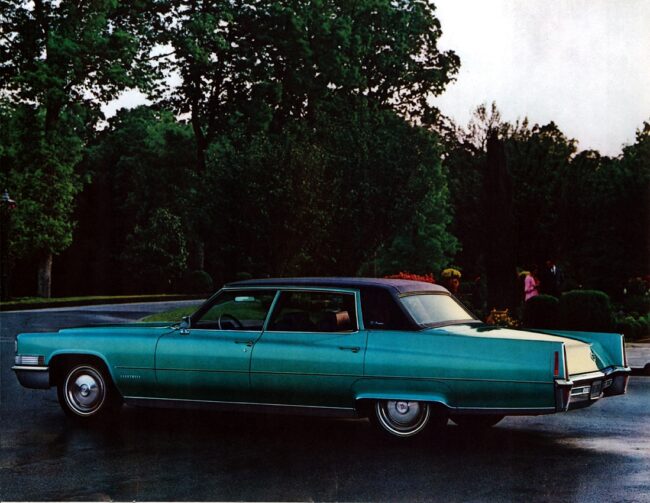
This Brougham, from the ’70 brochure (I have at least three copies), looks wonderful in Lucerne Aqua Firemist, but then I’m a sucker for aqua, blue and green cars. Like Lincoln’s contemporary Moondust colors, Firemist paints had a high metallic/pearlescent effect compared with the “standard” color choices. Firemist colors were available on all 1970 models for an additional $205.

While some of the interior appointments were not quite of pre-1968 exuberance, thanks to new Federal regulations frowning on reflective chrome and stainless steel trim, the cabin still offered an abundance of well-tailored leather, fine fabrics and most certainly, plenty of stretch-out room. Which is exactly as it should be, since the Sixty Special and vinyl-topped Brougham were the largest Caddies in the lineup save the Seventy-Five Series Sedan and Limousine. We’re talking about 133 inches of wheelbase, 228.5 inches of overall length and a road-hugging weight of 4,835 pounds (or 4,830 lbs. for the steel-roofed Sixty Special).
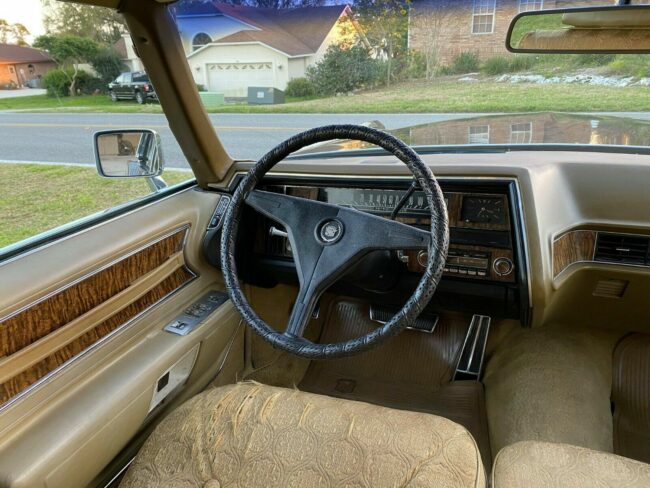
A lot of folks of a certain temperament like to blast Cadillac for cheapening their interiors post 1966. But keep in mind that 1968 brought much stricter limitations on the amount of chrome and other bright interior trim in American cars. Some of these folks think GM should have just said, “Hey! F the regulations! Let’s just keep doing what we’re doing and pay all the fines! Hell yeah!” Oops, never mind, I usually just think that part. Anyway, the inevitable result was a somewhat drabber look for instrument panels, steering wheels and door panels. Considering the level of trim and furnishings expected in a luxury car, the new regulations surely hit Cadillac harder than, say, Plymouth or Chevy. That said, I personally find the ’70 dash attractive. Especially in the aqua, red or blue interior choices.
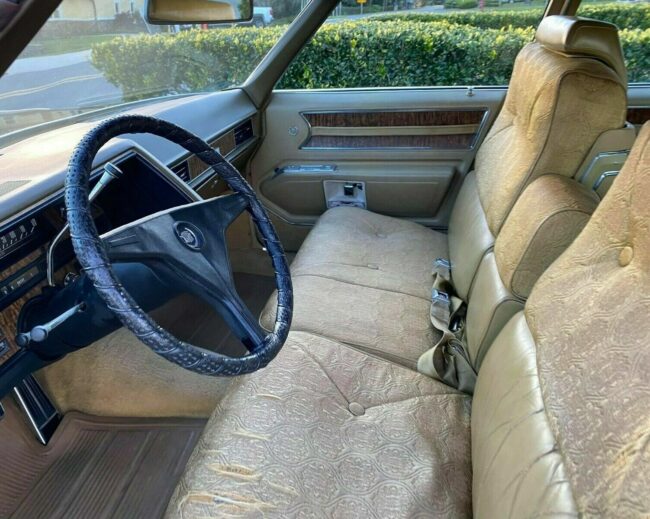
That aside, there still was a lot that recommended the 1970 Cadillac, not the least of which was its proven powertrain. At its heart was the 472 cu in V8, which featured five main bearings, hydraulic valve lifters, and a Rochester four-barrel Quadrajet Model 4MV carb. Not surprisingly, it provided power, torque and durability that were second to none. Still rated at 375 hp and 525 wonderful lb-ft of torque, it also gave up nothing to the 1968 engine. As the saying went, a Cadillac could pass anything but a gas station. Turbo-Hydramatic was an expected and welcome standard feature.
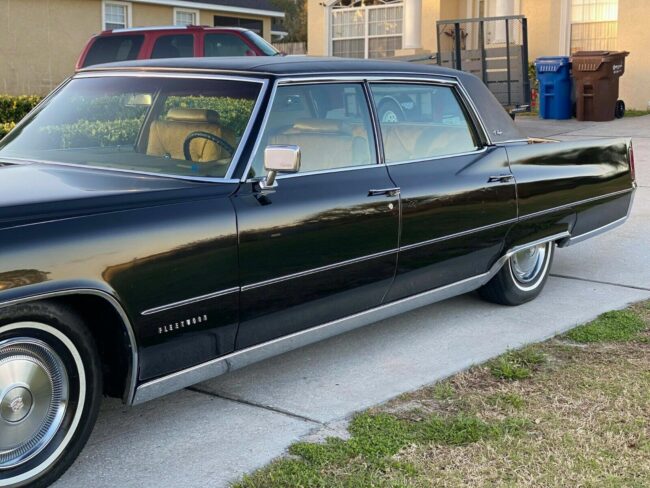
Just below the $7,284 Sixty Special Brougham was the “plain” Sixty Special, which eschewed the Brougham’s padded vinyl roof. While much the same as the Brougham, it was priced at a slightly lower $6,953. A mere 1,738 Sixty Specials were built for the 1970 model year, versus 16,913 Broughams. Small wonder 1970 was the steel-roofed Fleetwood’s last year; it would be absent from the 1971 roster.
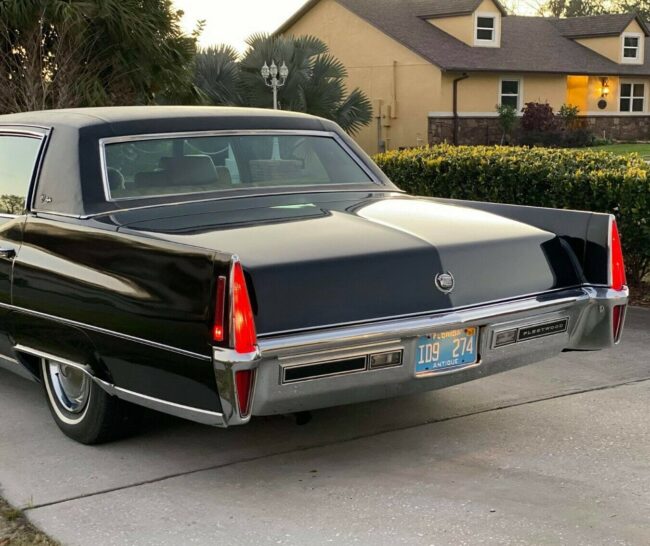
Whether a Sixty Special or Sixty Special Brougham, Fleetwoods offered all of the features of the de Ville series along with automatic level control. As you’d expect, the stitching on Fleetwood seats and door panels was unique, and complemented what the 1970 brochure described as “the rich look of oriental tamo wood on the doors and instrument panel. Sixty Specials offered a choice of seven sumptuous leather interiors, four Dumbarton cloth-and-leather selections, and four upholstered in Divan cloth. And there were colors–lots of colors. Remember when car interiors offered real colors?
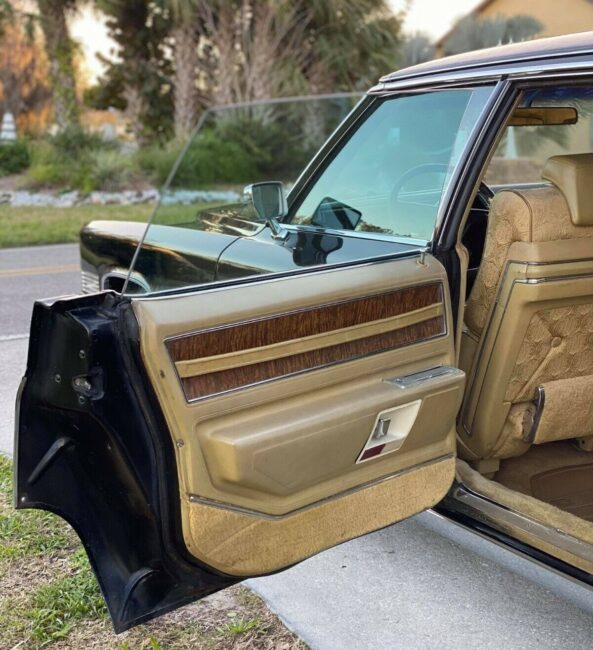
The Brougham set itself apart from the Sixty Special primarily with its oh-so-current padded vinyl roof, but also featured adjustable rear-compartment reading lights, folding carpeted rear footrests and a two-way power Dual Comfort front seat. Full power control of the seats could be had for an extra $90-$116, depending on the model. Both the Sixty Special and Brougham received thin horizontal chrome belt line molding, bright wheel opening moldings and a wide chrome rocker molding with rear-quarter panel extensions. Fender skirts? But of course.
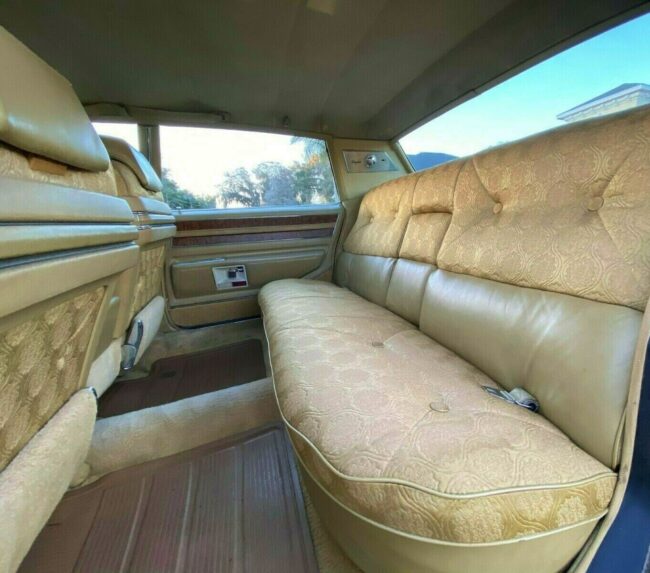
All in all, Cadillac had a good year in 1970. It produced 238,745 vehicles, a marked improvement over the 223,267 built in 1969. In fact, 1970 production set an all-time division record, despite disappointing calendar-year sales of 152,859 units, a performance due in large part to the major GM strike that, well, struck during the 1970 model year.
A 1970 Cadillac may have been a bit cheaped-out compared with a 1962 or 1963-64 model, but to my eye it remained every bit a Cadillac. Just look at that back seat. Comfy, yes? What’s more, 1970 Caddys were safer, thanks to new 1968 Federal safety regs. Lap belts were provided for every passenger, along with shoulder harnesses for the two outboard front-seat passengers. A dual-circuit brake system (a Cadillac feature prior to 1968); headrests; an energy-absorbing steering column; anti-glare dash top and A-pillar covers (the bane of all you chrome-loving ’60s Cadillac interior lovers); and power front disc brakes with finned rear drums were present and accounted for on every 1970 Caddy.
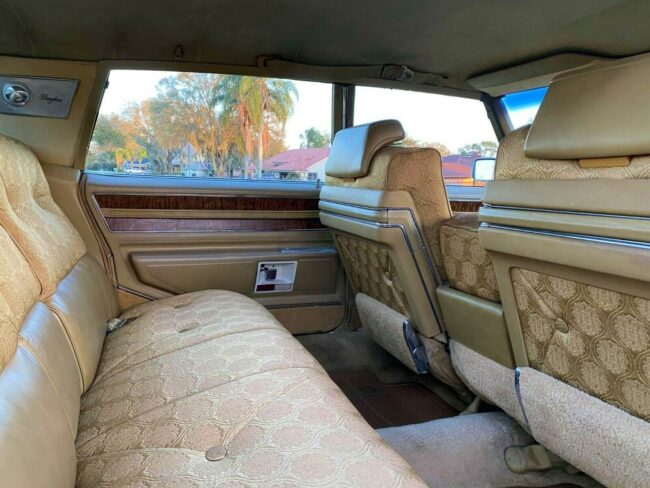
I actually got to ride in one of these. As mentioned further up, a grade school friend’s mom had a gold ’70 Brougham with a white top and white leather interior. They actually had a thing for old Cadillacs, since they also had a navy blue ’69 (I think) Seventy-Five sedan. Both cars were a bit worn out, but still did their fine pedigree proud. Anyway, there was a class trip to the Rock Island Arsenal when I was in second or third grade, and Luke’s mom was one of the drivers. Guess who I rode with? It was a cool car that was great to ride in. To this day I have fond memories of that car. She kept on driving it daily for years, even though it steadily got rougher. The last time I recall it running I was in maybe sixth or seventh grade.
Years later, I ran across the very same car (it’s hard to miss that color combination) in the local junkyard, probably around 1994-95. I was sad to see it had succumbed, but I guess it was nice to get to see it one last time. I took the Fleetwood Brougham plaque off the instrument panel as a souvenir of a happy childhood memory. To this day, it sits on my desk at home.
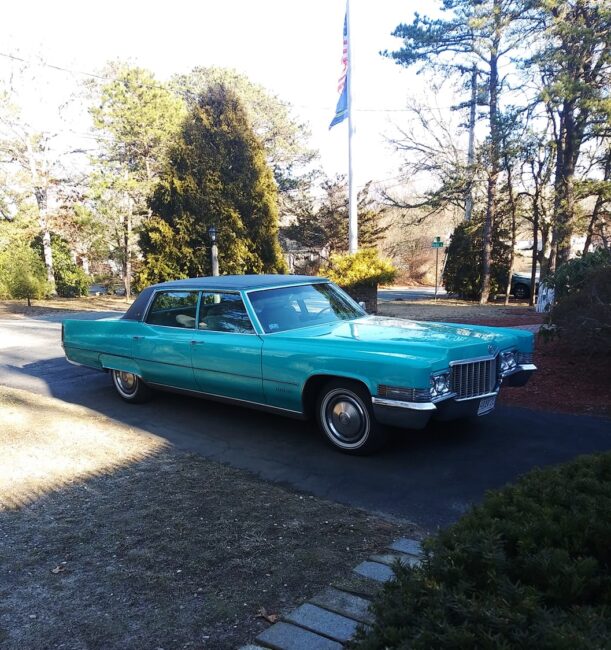
Yes, 1970 was a good year for Cadillac, and in my opinion, a good year for Cadillacs. However, it was all about to change as Cadillac Motor Division, in its relentless pursuit of profit and sales records, drastically decontented the 1971 models. I like them, but I don’t think they can match 1970 and earlier Cadillacs for sheer quality and presence. As for the featured black and gold car, it’s still on eBay as of this writing, seek it out here if you’re so inclined.
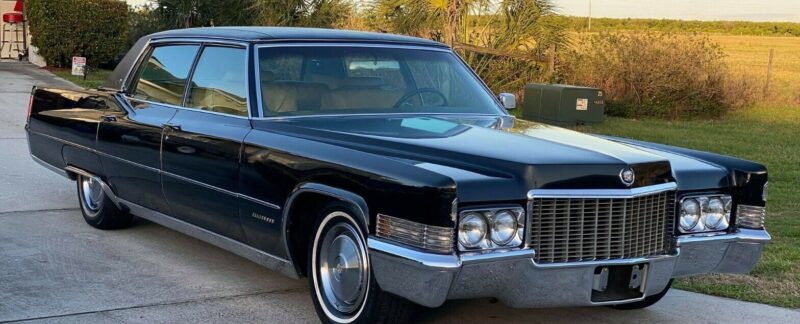

My opinion is that the last year the Cadillacs were real were 91 for the Seville/Eldorado, 92 for the Brougham, and 93 for the Deville. By that point GM management thought Opel was their premium brand.
The Northstar was a late but welcome upgrade for Cadillac, but as was so often the case with GM since the 1970s they cut corners on development and were slow to fix the headbolt problem. Such power was also largely wasted in the transverse FWD applications that Cadillac had 100% converted to. Thus it is difficult to say when the last real Cadillac was made. The 77-79 downsized C-Body were nicely done and welcome improvement over the bloated and cost cut 71-76 generation, and before Cadillac started to experiment with low power but highly unreliable powerplants, but by then Cadillac was already widely considered a mid-market brand and not a serious competitor to the high status and much more expensive Mercedes, Jags, or Bimmers or even the upscale with a touch of anti-capitalism Volvo and Saab. I’d probably have to say the last real Cadillac as indicated by its still widely viewed as the top of the line status brand with nothing to be ashamed about in terms of technology (except for the lack of disc brakes) or quality of materials and workmanship were the 1966 models.
Too bad that management agreed with you that Northstar was an improvement and Euroland which for GM meant Opel Omega was the future. It turned not to be a program for success
I think I already caught this argument on a re-run….I’ll see whats on another channel, maybe I can catch something exciting like the 700 Club….
“… the upscale with a touch of anti-capitalism Volvo and Saab.” Beautiful!
There was a time when you waited for the inevitable appearance of a Volvo wagon in every Lifetime Original movie (hey, I was married then!).
“At its heart was the 472 cu in V8, which featured five main bearings…”
Don’t all V8’s “feature” 5 main bearings? There are 4 rod journals – 2 rods per journal – which means 3 main bearings between the journals and two on the ends. Did you mean 4-bolt mains? Although it’s entirely possible I’m missing something about earlier V8’s…
…at any rate, that black Cadillac is gorgeous. I think Mr. Klockau has finally got to me. One of these days I’m going to cash out my race cars and SUV tow vehicle and just have one Brougham land yacht.
Some early V-8s such as the Ford flathead and Cadillac flathead were 3 main bearing motors. Bearing count generally went up when manufacturers converted to OHV designs due to better breathing that allowed higher revs, although the top versions of the Packard straight 8 (flathead) had 9 main bearings for extra smoothness.
I can’t help but wonder when we will start seeing a lot of these old guzzlers start to get converted to Tesla or the new GM electric drivetrains. Certainly lots of space to hide a large battery pack, and tax-free electricity and greater EV efficiency would certainly make it less financially painful to drive one of these while improving on their already silky smooth power delivery and low end torque.
I wonder if the cost of an EV conversion wouldn’t be more than the cost of buying gas for this car for the rest of its existence.
I’m sure it would never make any economic sense unless Biden starts offering some big subsidies to fire up some more “green” jobs, but no resto-rod is ever done for economic reasons.
Give Youtubes’ “Rich Rebuilds” a call. Converting something like this would PO everyone. The Tesla crowd would scream that sticking an electric drive train in 2 tons of fun is stupid, and the Amelia Island crowd would scream sacrilege.
Got to get those view clicks in. I wish they’d finish the Camaro V8 being shoved into a Tesla instead of trying to convert an old Fed Ex MB van into a motor home.
Heck, I just watch for the seamless segues into product placement.
Carlson’s mom had got it goin’ on!
Tom,
I agree with you on the exterior…still ‘peak caddy”. I just could never get over the interior. Seats were still great, but the dash and door panels were so cheapened, bad fake wood and plastic chrome that wore to black at a glance. Substandard plastics didn’t help. This was a Fleetwood for heaven’s sake! I test drove a ’70 Deville convertible just after getting out of the Navy in late ’69 and was just amazed at the difference three or four years made in the interior execution. But I still remember the drive!
No shots under the hood?
When I was in high school in the early 80s we had a ’75 Fleetwood with the 500. Keep in mind, the ’75 had a first gen catcon, low compression, etc, but it could still get rubber from a stop. I remember racing a friend with his dad’s 75 Olds 98 w/ a 455. We were pretty much evenly matched.
If you click the link for the ebay auction, there’s a couple of engine pictures.
Thank you sir!
re “Pay the fines” was there a specific exec that deemed all of their vehicles would meet CAFE? Among the many, so many, decisions made by GM suits, I never understood why they didn’t just sell a bunch of shitboxes to make up for properly classy Cadillacs in the 70s and 80s or the 1 to 4 on the ZR-1. So much brand equity was squandered for nothing. Although, considering the Collective Responsibility of the Stepford Wives out of Kettering maybe there wasn’t one person.
The mandate to not pay any gas guzzler fines came from the top floor of the GM HQ, and since they were slow and/or too cheap to use technology to maintain performance while improving efficiency, they ended up gutting their big cars. Why did it take Cadillac almost 10 years after the first fuel crisis to develop a 4 speed OD automatic? Why didn’t they make fuel injection standard on their upscale brand V-8s? Why did it take them 14 years to adopt lighter unit body construction on their big cars, or almost 20 years to develop an OHC V-8?
On the other hand, the Feds also tied Detroit’s hands by not allowing captive imports to count towards their CAFE numbers, so they had to use expensive UAW labor to build small cars in the USA that never made any profit. Thus selling lots of cheap small cars in order to sell a few gas guzzlers wasn’t a very attractive financial option, which is why GM ended up selling full-size Cadillacs with 125 HP V-8s and Buick V-6s and 105 HP Olds diesels.
This article has a a lot of us thinking why wasn’t Cadillac building an American Rolls Royce or Mercedes 600. Well remember Lincoln or Cadillac was and is doing something special for the President, as a special patriotic act, If they did a few more for the billionaire/ rap mogul class, that class would just disappoint as it always does by showing how little they identify with where they live, passports are just for convenience.
Think instead of 70s Cadillac, expanding their offerings and volume by not quite matching the eras rampant inflation. That got the car in the hands of local people even in the small towns. These are people that it was easy to respect and Cadillac was respecting them by building for them. No the hippys didn’t respect them but when has anyone benefited from listening to them.
In contrast, think of the owners of the W116 Benz in comparison to the previous S class. You were seeing a lot more of the ever expanding bloodsucking class in them. So despite the W116 success as a car, it is treasured today nothing like the previous.
GM didn’t need to “not quite match the eras rampant inflation” by building cheaper Cadillacs – they have Buick and Olds for that purpose. In fact that was the problem – there really was no Cadillac advantage over a comparably equipped Olds 98 or Buick Electra from the late 60s onward. You could get the same gadgets on all of them, they all had OHV V-8 with about the same power and torque, with the exact same automatic gearbox, they had the exact same front suspension and live rear axles and front disc brakes and rear drums. The interiors had the same molded plastic dashboards and plastic chrome and plastic wood adornments, and when they switched to FWD in the mid-80s they had the exact same exterior styling that Lincoln made fun of in their ads. Besides the badge and a glorious history of V-12s, V-16s, and glamourous owners (Elvis!!!) what was the Cadillac owner getting for the extra money?
GM certainly had the parts bin to do better. Why not a coil-over version of the Corvette/Corvair independent rear suspension on every Cadillac for better handling and better ride? Why not make the Corvette’s 4 wheel disc brakes standard on Cadillacs? Why not make electronic fuel injection standard on Cadillacs instead of an expensive option? Why not bring over a Cadillac version of the Opel Diplomat/Senator instead of making a Cadillac out of Nova or Cavalier? Why not use some real wood veneer and real metal buttons and switches to offer a tangible advantage in quality over the Olds or Buick? Why not – because it would have meant giving up a little volume and GM was much more interesting in trading off brand equity for volume which is why they destroyed all their mainstream brands.
Cadillacs cost more even in the 1970s than Olds and remember at the time the upper middle class was still expanding as were finance terms.
As far as incorporating new tech, let me point to Rolls Royce. When the Silver Shadow came out in 66, all the new tech was added at once, at an only possible once a generation expense. The result was mediocre because they were just mot able to get the new tech to perform in terms of new metrics like ride and quiet as the old tech of the separate body Rolls that always had that priority. Remember rebodied Silver Shadows lasted till 2010 and from then on the mine’s quieter taunt had to be endured, though not from the Germans. An OHC V12 unit IRS Caddy in 1971 would no doubt faced the same fate as Lincolns were getting seriously quiet with the move away from unit construction.
Yes little Rolls Royce introduced a Shadow in 1966 that was technologically the most advanced car in the world (with possible arguments in favor of the MB 600). Imagine what GM could have done with all the resources and engineering talent they had? Imagine a 1967 Cadillac with an all aluminum V-12 with Rochester Fuel Injection, 4 wheel disc brakes, 4 wheel independent suspension with sophisticated mounting to the body to reduce harshness, real wood, real leather, and the world’s best climate control system and automatic transmission, etc. all thoroughly tested on thousands of GM cars and/or with hundreds of hours of testing at GM test tracks and labs, and priced at levels that only GM economies of scale and manufacturing expertise could provide. Mercedes, Jaguar, and BMW wouldn’t have known what hit them.
You guys are so predictable. “Duck Season!” “Rabbit Season!” “Duck Season!” “Rabbit Season!” Hahahahaha
When you say what you believe consistently, the smartur folks can begin to predict. Good for you for having the ability..
You got consistent down…thats for sure……..now get to work on making sense and you’ll be 20% of the way to being understood…..
You ask a lot. Maybe I should start by learning to spell smarter.
Carmine & John C, how long have your two been dating. You go at each other like you have been together for years there on Tybee Island. 😉 😉
Sorry Lynn I prefer alternate plumbing arraignments. and anyway convenient Tybee is a bit cheesy for my more high brow tastes. I think Carmine and Stingray prefer Heritage USA.
Back on topic ;
These two cars are glorious .
As much as I like pastel colored vehicles, this one looks better in basic black to me .
I wish I had the space for one but in truth I don’t like driving big cars, just enjoying them .
I didn’t realize the Mercedes W116 was still popular .
-Nate
Thanks Tom.
Your article stirs great Cadillac memories, starting with Uncle Freddie and Aunt Mary’s 1958 Sedan de Ville, black, all tail fins and dual headlights (so modern!). I would have been six at the time. They later drove a ’67 finished in a light metallic that looked like the ’60s Corvette color Marina Blue. Even though your photo of the driver’s seat is from several years later I remember the steering wheel with the triangular center. Freddie, a stubby fellow who looked like a cross between Don Rickles and Mel Tormé, would hop behind that tilt wheel (leaving it in the up position), back out of his driveway and mat the huge gas pedal with a self-satisfied smirk on his face as we’d hurtle down a slight grade with trees on either side. My parents, who didn’t drive, were never thrilled when I’d go for a ride with Uncle Freddie but I loved it!
My next up close and personal Cadillac experience came in high school when a classmate would occasionally borrow one of the two cars his parents drove: a ’69 convertible de Ville in Lucerne Aqua Firemist and a ’70 gold Brougham. The ‘vert was sexy as hell but for our purposes my classmates and I favored the Brougham.
Mid-sixties to early-seventies American cars are among the most handsome ever designed. And I’m talking regular sedans, coupes, wagons and convertibles, never mind Camaros, Firebirds, Cougars et al.
Keep doing the voodoo that you do do Tom!
Can someone educate me on the 1968 interior safety regs? I’m guessing that’s what did away with toggle switches, etc, but why did the interiors turn so dramatically worse?